Mold is pretty easy to understand. No water no mold. Any questions? Well, there are a few. For one we have more mold today, but we don’t have more water. What’s with that? We’ve always built outside out of wet stuff. Concrete comes in a big truck and we “pour it.” We put “mud” in the joints of gypsum board. That hasn’t changed. The problem is that the same amount of water we’ve always had to deal with is hanging around longer and longer in building materials that can’t take it. We have more insulation today and that reduces drying potentials because it reduces energy exchange. That is one reason we have more problems with mold today. The “more insulation” is responsible for the water “hanging around longer” part. But there is another reason—the building materials “that can’t take it” part. We used to build out of rocks and 1,000 year-old trees. Not any more and that is a big deal, as we will see.
From an engineering perspective all that mold needs is carbon—to boldly go where no mold has gone before and seek out and find carbon. But it wants the carbon in a very special form—it wants it in the form of sugar. So, all the mold wants is the carbon in sugar. Now, we don’t talk that way because we don’t want civilians to catch on. We say that mold wants the carbon in a glucose polymer called cellulose—it makes us sound smarter. So where is all the cellulose? It’s in the plant kingdom. So, all the mold wants is the carbon in the cellulose in the plant kingdom. Pretty easy so far. But there are certain rules that the mold has to follow—one of which is that the plant has to be dead first. So what do we build out of? Naturally, dead plants.1
We go out and kill the tree, butcher the tree - commit tree genocide.2 We used to cut the tree into timbers and large boards. With timbers and board lumber we had few mold problems because mold could not burrow into the timbers and board lumber and access the carbon in the wood fiber. Young, violent, vicious, aggressive mold could not break the board lumber down. Mold was principally a surface phenomenon with these materials—you could wash the mold off the surface of the timbers and wood boards with soap and water and elbow grease and be done. All those folks running around with HEPA vacuums, sanders, dry ice pressure blasting and negative pressure containment were just a “tax” on stupid people.3 What did P.T. Barnum say about never underestimating the stupidity of the average American consumer?
But we don’t build much out of timbers and board lumber anymore. Instead of cutting the tree, we peel the tree and smush the layers together under heat and pressure. We cook the raw wood meat to tenderize it and make plywood. The plywood goes out to the job site slightly brownish in color because we’ve caramelized the wood sugars—we’re making mold candy. If you’re mold and you have a choice between timbers, board lumber and plywood what are you going to choose? Plywood.
But we don’t build much out of plywood anymore either. Instead of peeling the tree, we flake the tree, add glues and waxes and the Colonels’ “eleven secret herbs and spices” and we smush all of that together and make Oriented Strand Board—OSB. I call it “was-wood”—it was wood once, but it ain’t wood no more. I call OSB the Spam of wood, actually I call Spam the OSB of luncheon meats. If you are mold and you have a choice between OSB and plywood what are you going to choose? OSB (see Photograph 1).
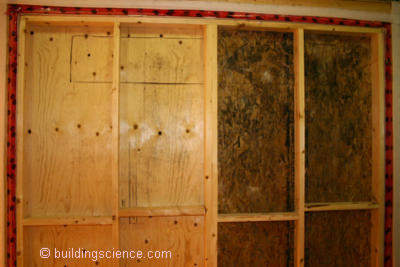
Photograph 1: OSB versus Plywood—At the University of Waterloo “skunkworks” an OSB panel and plywood panel are exposed to identical temperature and humidity conditions over the same time period—the panels were side by side in a climate chamber. The OSB is covered with mold—the plywood is pristine. Now don’t everyone run out and stop using OSB—we have to use OSB—get with the program—just learn to protect the OSB better.
Remember the old days—crawlspaces constructed with dimensional board lumber—2 x 10’s sheathed with plywood. Now we have I-joists and OSB sheathing. We almost never had mold in these assemblies in the old days—now when you mention crawlspaces mold is in the very next sentence.4
Are we done yet? Not by a long shot. When we flake the tree we now put the flakes in a giant pressure cooker, pressurize to a couple of atmospheres at a couple of hundred degrees, pop the lid and the flakes explosively decompress to create fibers in a process developed by William Mason early in the last century. We then put the fibers in a vat, get a bunch of Witches that chant—“double, double, toil and trouble, fire burn and cauldron bubble”—and presto we get hardboard. If you are mold and you have a choice between hardboard and OSB what are you going to choose? Hardboard.
Now we can take the fibers and grind them up into sawdust and then compress them all together with glues and nitrogen. And we get particleboard. Where do we get the nitrogen? From the back end of a cow—urea from cow urine. What do you think the particleboard smells like when it gets wet? What do we make out of the particleboard? Floor underlayment, cabinets, furniture, tables. The nitrogen is like Cajun seasoning to the mold. If you are mold and you have a choice between hardboard and particleboard what are you going to choose? Particleboard (see Photograph 2).
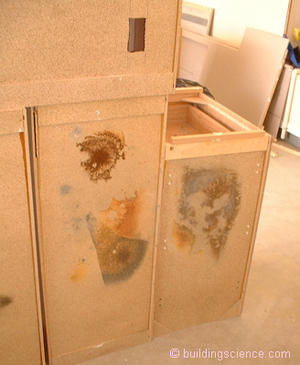
Photograph 2: Grass Cabinetry—Greenie weenie compressed grass laminate used in kitchen cabinets didn’t fare very well in this “award winning” sustainable community. Solution? Get rid of the grass stuff? Nope. Back vent the cabinets.
What next? We dissolve the fibers and reconstitute them and get paper. Old mold with no teeth can eat paper. What do we do with this paper? We laminate it to both side of gypsum board. We make paper-faced gypsum board. And what do we do with this gypsum board? We line the inside of our buildings with it. If we build commercial non-combustible assemblies we line the outside of our buildings with it. We build our demising walls, our shaft walls, our service walls, and our party-walls with it. We are in essence building paper buildings. Even the dumbest of the three little pigs didn’t build his house out of paper.
And then what do we do? We color the paper green like we are going to fool the mold. And then where do we put the greenboard? In a shower. Let’s put green paper in a shower and cover it with “lick and stick” tiles—there’s a good idea. Coloring the paper green to protect it from mold is like putting lipstick on a pig—at the end of the day you still have a pig (Photograph 3).

Photograph 3: Greenboard—It’s not a good sign when the mold is already on the greenboard before the tiles are installed. What gives? The waxes added to protect the paper from liquid phase water—to meet a ridiculous ASTM spec—are “mold food.” When products are optimized to meet arbitrary ASTM specifications rather than optimized to meet the “real world” problems result. Of course paper in a shower regardless of color is pretty dumb.
So what do we do? Not use paper-faced gypsum? No, paper-faced gypsum is one of the miracle products of the last century. It made housing affordable and is the mainstay of commercial construction—it replaced wet applied interior finishes such as plaster and lath. “Drywall” replaced “wet walls.” What we have to do is not use it in wet areas. Don’t put paper-faced gypsum in a shower or the outside of your building or in a party-wall that is constructed before the roof is on and the building is “dried in.” We have other products such as glass-faced gypsum and cement boards for these applications. Paper-faced gypsum is a fantastic material that we are going to use well into this century—but we are going to have to pick our spots where we use it better.
Let us now think about the big picture. What has been going on over the last half century in the construction industry? As we have moved down the process stream from timber, board lumber, plywood, OSB, hardboard, particleboard, to paper laminates - each step of the processing has made the products more water and mold sensitive. Are we going to stop this trend? What are the odds of going back and building out of thousand-year-old trees and rocks? Not going to happen. We have to come to terms with the fact that the building materials we use today are far more mold and water sensitive and are likely to remain so for the foreseeable future.
Engineered wood products such as OSB and I-joists and other composites are here to stay—in fact they are more desirable as I believe they are significantly more environmentally responsible. I believe that we are going to see a transition from a hydrocarbon-based economy to a carbohydrate-based economy. We are seeing this in the energy sector and I think we will see this in the materials sector.
Getting our cellulose fibers in Iowa, Mississippi and Georgia on plantations makes a lot more sense than getting them in the Old Growth Forests in the mountains of Oregon and Washington State. Managed forests and plantations are the way to go. But there are problems with these cellulose based engineered materials as the preceding discussion shows.
We are going to have to be more careful in how we use them. They have to be protected more during the construction process and the building assemblies these products are used in will have to be designed differently. The micro-climates these materials are exposed to are going to have to be different from the micro-climates traditional building materials were exposed to if they are expected to last the service life of the building. And if they get wet and damaged and become moldy—soap and water or painting them over is not going to do the trick. They probably are going to have to be removed (and removed carefully) and discarded. The old days of soap and water are probably gone where the new stuff is concerned.
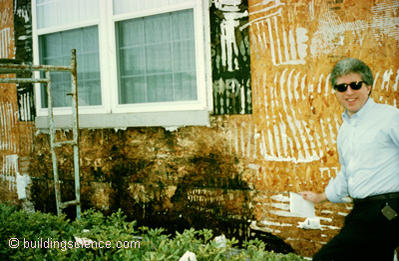
Photograph 4: Window Openings 1—Leaking windows and OSB are a match made in consultant heaven. Notice the smile on the famous unidentified consultant. Of course the EIFS cladding had a little to do with this as well.
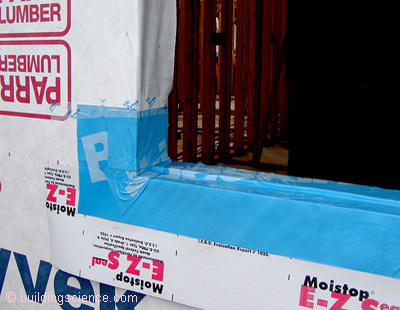
Photograph 5: Window Openings 2—Notice the pan flashed opening. The products are discretely left unidentified.
The trends are already obvious. Every window and door opening will have a pan flashing because incidental water is no longer tolerable with engineered materials (Photograph 4 and Photograph 5). We have committees and manufacturers going crazy figuring out installation practices for windows and doors. No double vapor barriers allowed.5 Crawlspaces are going to have to be constructed “conditioned” or will have to have use rigid insulation to protect OSB based I-joists and OSB based sub-floor sheathing from exterior moisture (Photograph 6 and Figure 1). Greenboard in wet areas has just been banned in the Model Codes6 (Photograph 7). We are going to have to back vent our cabinetry. And this is just the beginning.
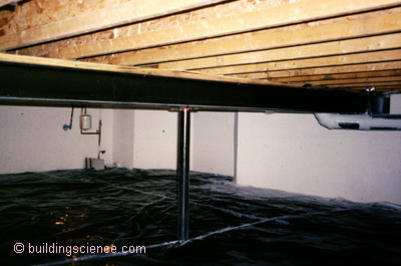
Photograph 6: Conditioned Crawlspace—Constructing crawlspaces like mini basements locates the engineered products within the interior environment.

Figure 1: Protected Vented Crawlspace—Rigid, non water sensitive, vapor impermeable insulation is installed on the underside of the floor framing and floor sheathing creating a micro-climate suitable for engineered wood structural framing and sheathing.
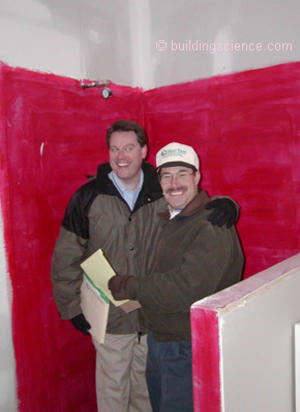
Photograph 7: Cement Board Shower Enclosure—A happy couple inside a cement board shower enclosure that has been coated with a liquid applied waterproofing prior to the application of tiles. They are happy as they are service and warranty personnel from a major production builder—they are celebrating the banishment of greenboard.
There will be more; I just don’t know what it will be. There is always more. But if we know the trends we can watch and catch things early. So lets be careful out there as we move down the road to sustainability and energy security. What has sustainability and energy security got to do with this? Sustainability will mean more engineered materials and more of the engineering materials will be cellulostic-based, and therefore there will be more of a mold risk. Sustainability and energy security together will mean higher levels of insulation and higher levels of insulation mean lower drying potentials and therefore there will be more of a mold risk. The days of uninsulated buildings constructed out of 1,000 year-old trees and rocks are over.
Footnotes:
The preceding rant is not strictly true, but it is close enough - it is “approximately true,” as is befitting an engineer.
I am pandering to the environmentalist crazies here in order to communicate with them. When I get a chance to talk to them I will say: “Wood is good.” It is renewable, stores carbon and we have a lot of it. We should use more of it. It grows …I can’t resist saying this…on trees.
Mold on paper products and engineered wood is a different story altogether, so no nasty letters until you read further.
Crawlspaces are now also insulated—remember the hanging around longer part—and the spaces above them are carefully kept at 72 F by ASHRAE members during the summer.
Big code changes have happened here recently, hooray. The Model Codes don’t prevent you from installing a double vapor barrier, but for the first time the Model Codes don’t make you install one. It is no longer a code violation to design and build a wall that actually works.
